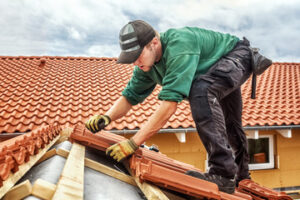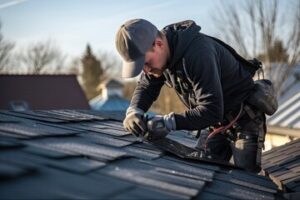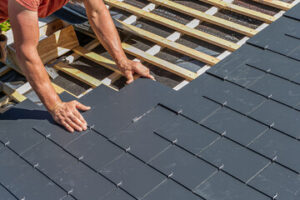Roofers In South Jersey ensure that buildings are adequately protected from rain, snow, sun, and other elements. They install, repair, and replace roofs, and often collaborate with other construction specialists and contractors.

Roofers tend to be independent, stable individuals who are persistent, genuine, and practical. They enjoy tasks that are tactile, physical, or athletic.
Roofers provide maintenance, repair, and replacement services for residential and commercial roofing. They have the skills and knowledge to properly install a variety of roofing materials, including shingles, tile, metal, and flat roofs. They also know how to properly ventilate a roof and apply weather protection measures. Without a well-maintained roof, buildings are at risk of water damage, structural damage, and mold growth.
Service roofers can perform routine maintenance tasks such as removing debris and cleaning gutters. They can also inspect a roof for signs of wear and tear, and recommend repairs or replacements as needed. In addition to these services, they can also install solar panels and other energy-efficient upgrades.
Leaky roofs are a common problem that can cause severe water damage if left untreated. A qualified roofer can quickly detect leaks and fix them before they worsen. They can also help homeowners and business owners file insurance claims to cover the cost of a new roof.
Local roofers understand the unique challenges that each region faces when it comes to roofing. They can recommend the best materials to use based on climate conditions and ensure that the roof is well-installed so it will withstand harsh weather conditions.
Professional roofers are highly trained in handling various roofing materials and can spot problems that may not be obvious to the untrained eye. They are also experienced in working at heights and adhere to strict safety guidelines to prevent injuries on the job.
A reliable roofer will have excellent customer service and a solid warranty on their work. This can give building owners peace of mind knowing that they won’t have to worry about faulty installation that can lead to roof leaks and other problems down the road. In addition, a good warranty will cover medical expenses for workers who are injured during the course of a project. This is important because it can save companies a lot of money in the long run. This is especially true for smaller roofers who have a lower revenue and can’t afford to carry as much liability insurance.
Retail Sales Roofers
Roofing sales is a field where the right people can earn a six figure salary. The key to success is perfecting specific skills, implementing technology tools to your advantage and cultivating a wide network of contacts in the industry. For example, forming partnerships with local insurance adjusters and real estate agents can boost your sales and lead generation rates.
The first step to getting in the game is to set clear goals for yourself. Using SMART goal-setting will help you achieve your goals and stay on track for success in the roofing business.
You must also be prepared to answer tough questions from homeowners that are skeptical of your company and services. They may tell you that they are currently working with another roofer or will get multiple quotes, and this is a good opportunity to explain why your company is the best option for them.
Some of the skepticism stems from fear of being taken advantage of, so you can use your experience to show homeowners that you’re not about to push them into a sale they don’t want. Using classic sales tips such as those from Zig Ziglar, you can balance information and emotion with your prospect. If you give too much information, the prospect might feel overwhelmed and won’t act, whereas too little information may result in the prospect buying a new roof but feeling buyer’s remorse later on.
A large roofing company with a sales department that specializes in both retail and storm chasing (more on this type of roofer below) can handle a larger volume of work and typically have better customer service departments. They are more likely to have long, formal sales presentations with all decision makers present and to offer in-house financing, including zero-interest options.
They will be able to provide you with a range of options for your roof replacement and will likely start with their highest-priced product and then negotiate downwards. They can also offer a longer warranty than the small business roofers because they have more resources at their disposal. They may also offer a wider variety of color and material choices than the smaller, independent roofers.
Storm Chasers
A storm chaser conducts field meteorological research to report tornadoes and other high-impact weather conditions to the weather bureaus. This important data is vital for accurate weather forecasting and advanced warnings to prevent casualties. A storm chaser also takes close-up photographs and videos of severe weather and sells them to various media agencies. A storm chaser may be a freelancer or work for a news agency, television program or website.
In general, storm chasing is a recreational pursuit. Chasers often cite their reasons for pursuing storms, which can include a love of photography and videography, intangible experiences such as feeling one with a much larger and more powerful natural world, the challenge of correctly forecasting and intercepting a storm from optimal vantage points, and pure thrill seeking. In addition, pecuniary interests and competition are common motivating factors.
The heightened profile of storm chasing in popular culture resulted from three major spurts: the broadcast of a 1978 episode of the TV series In Search Of…; a 1985 documentary on the PBS series Nova; and the 1996 movie Twister, which depicted two competing teams of storm chasers zooming through an Oklahoma city in their armored tornado intercept vehicles. However, the reality of a storm chaser’s life is much more mundane than the Hollywood version.
Early on, storm chasers used to acquire all of their meteorological data for the day early in the morning at the local National Weather Service (NWS) office or a payphone. They analyzed this data and made forecasts, while stopping at rural airstrips or other weather-related locations to obtain visual clues. Later, the laptop computer revolutionized the chasers’ lives, allowing them to download raw surface and upper air data into plotting software such as WeatherGraphix (predecessor to Digital Atmosphere) and RAOB.
Today, most chasers use Doppler radar and mobile phones to monitor and track severe thunderstorm activity. They also have a network of websites and social media where they post pictures, video and news about the latest severe weather.
Several storm chasing operations offer tours for tourists who want to experience the thrilling spectacle of a tornado or other severe weather firsthand. While these tours are an economic boon for some chasers, they are not without their risks. The transient nature of these businesses leaves them vulnerable to fraudulent activities such as overcharging or performing shoddy repairs on homeowners’ properties in order to pocket insurance claim checks.
Insurance Roofers
Roofing contractors should have general liability insurance to protect themselves against accidents that occur on the job. This is an important type of business insurance for roofers because it helps cover medical expenses, settlement costs, and legal fees. Without it, a small roofing accident can cause financial ruin for the company. Clients also prefer to hire roofers who are insured because it shows that they take safety seriously and are prepared for unforeseen incidents during the project.
Workers’ compensation insurance is another policy that roofers should carry. It pays for an employee’s medical expenses, long-term care costs, missed work, and disability benefits. It’s mandatory in most states, and it can also help protect you from lawsuits if an employee is injured on the job.
Commercial auto insurance is another must-have for roofing businesses. It covers vehicles owned or leased by the company, as well as those that are rented or borrowed for work-related reasons. Personal auto insurance usually doesn’t offer coverage for this type of situation.
Finally, builder’s risk insurance is another important form of roofing contractor insurance. It protects buildings and other structures that are under construction from damage caused by weather, vandalism, fire, and other events. Most owners will require that the roofing company have this coverage before they allow them to start construction on the building.
Whether you are a service roofer, a retail roofer, or one of the other types of roofing contractors, it is important to understand the different types of roofing insurance available and what each policy offers.
A professional independent agent will be able to find the best options for your business. They will go over your current policies and determine if any gaps in coverage exist that could leave you open to litigation or other costly situations. They will also recommend any additional policies that you may need to be properly covered for your roofing business. They can even bundle two or more of your policies into a business owners policy to save you money.

